
What is Pro-Dense® Injectable Regenerative Graft?
Pro-Dense Injectable Regenerative Graft is a bone graft substitute that is a purely synthetic composite of calcium sulfate and calcium phosphate. These two materials are biocompatible and have been used in orthopedics for over 100 years. The formulation in Pro-Dense Graft, however, is unique and has demonstrated excellent results in benign bone cysts and tumors.1-3
Pro-Dense Graft is currently the only bone graft substitute on the market to be indicated specifically for use in benign bone cysts and tumors in patients 6 years and up. The product allows for an injection technique in simple or unicameral bone cysts, or as a backfill in tumors/cysts in open techniques.
How is Pro-Dense Graft applied?
A generalized surgical technique is demonstrated below:
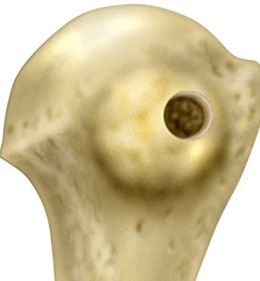
Step one
Localize the lesion under fluoroscopy. Create cortical access to facilitate curettage.
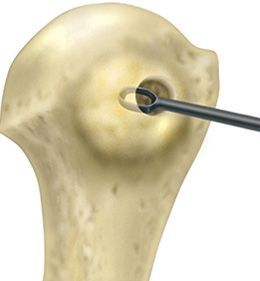
Step two
Using an image intensifier, excise the lesion, using a curette to debride defect margins. Excised tissue should be sent to pathology for routine histological examination and culture.
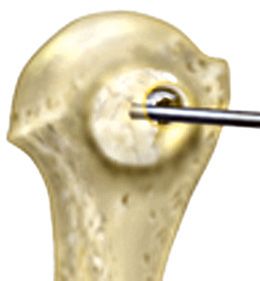
Step three
Having debrided the defect area, use the included delivery needle to inject Pro-Dense Graft into the defect.
What happens after application?
After implantation, the bone graft resorbs over time and allows the body to lay down dense new bone. This is different than other bone graft materials that take much longer (sometimes years) to resorb and be replaced by bone. In most cases, Pro-Dense Graft can be seen radiographically (i.e., on X-ray or CT) during postoperative visits. The surgeon will define postoperative activity level as the material resorbs and new bone heals and replaces the graft. The below case examples demonstrate how the material can be seen on X-ray and be replaced by dense new bone as the material is resorbed.
Case studies
Twelve-year-old male with a recurrent unicameral bone cyst of the right proximal humerus. Pro-Dense Graft was used to completely fill the lesion. No complications were reported. New bone formation was detected at 7 weeks, and at 7 months, a small amount of the residual graft was left. At 3 and 12 months, radiographs show dense new bone formation. Patient was fully active at 10 weeks and remains at full activity at present.

Preoperative
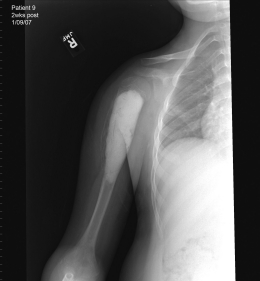
2 weeks postoperative
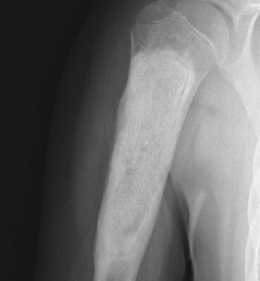
1 year postoperative
Images courtesy of: Robert Heck, MD - Campbell Clinic, Memphis, TN
Sixteen-year-old male with a painful benign bone cyst of the right proximal tibia. The preoperative image shows the bone cyst measuring approximately 6cm x 3cm. It was debrided and grafted. The 1 month follow-up exhibits slight resorption of the graft and the patient was pain free with an independent activity level. The 3 month image shows further graft resorption and apparent dense bone regeneration. The 9-month radiograph demonstrates almost complete resorption of the graft and dense bone regeneration.

Preoperative

6 weeks postoperative
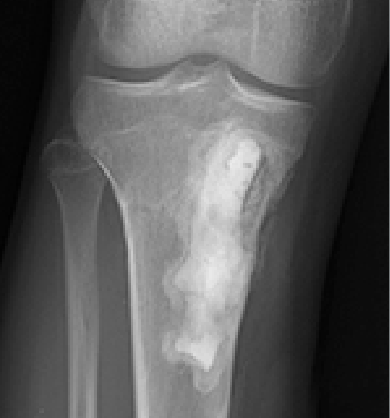
3 months postoperative
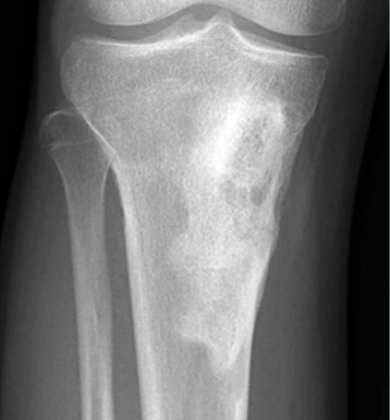
1 year postoperative
Images courtesy of: Mike Neel, MD - Ortho, Memphis, TN
References:
- Gentile JV, Weinert CR, Schlechter JA. Treatment of unicameral bone cysts in pediatric patients with an injectable regenerative graft: a preliminary report. J Pediatr Orthop. 2013;33:254-61.
- Evaniew N, Tan V, Parasu N, Ghert M, et al. Use of a calcium sulfate-calcium phosphate synthetic bone graft composite in the surgical management of primary bone tumors. Orthopedics. 2013;36(2):e216-e222.
- Fillingham YA, Lenart BA, Gitelis S. Function after injection of benign bone lesions with a bioceramic. Clin Orthop Relat Res. 2012;470(7): 2014-20.
Individual results and activity levels after surgery vary and depend on many factors including age, weight and prior activity level. There are risks and recovery times associated with surgery and there are certain individuals who should not undergo surgery. Only a physician can tell you if this product and associated procedure are right for you and your unique circumstances. Please consult with a physician for complete information regarding benefits, risks, anticipated implant duration and possible outcomes.
A surgeon must always rely on his or her own professional clinical judgment when deciding whether to use a particular product when treating a particular patient. Stryker does not dispense medical advice and recommends that surgeons be trained in the use of any particular product before using it in surgery. The information presented is intended to demonstrate the breadth of Stryker’s product offering. A surgeon must always refer to the package insert, product label and/or instructions for use, including the instructions for cleaning and sterilization (if applicable), before using any of Stryker’s products. Products may not be available in all markets because product availability is subject to the regulatory and/or medical practices in individual markets. Please contact your representative if you have questions about the availability of Stryker’s products in your area.
Stryker or its affiliated entities own, use, or have applied for the following trademarks or service marks: Stryker. All other trademarks are trademarks of their respective owners or holders.
The absence of a product, feature, or service name, or logo from this list does not constitute a waiver of Stryker’s trademark or other intellectual property rights concerning that name or logo.
AP-017078